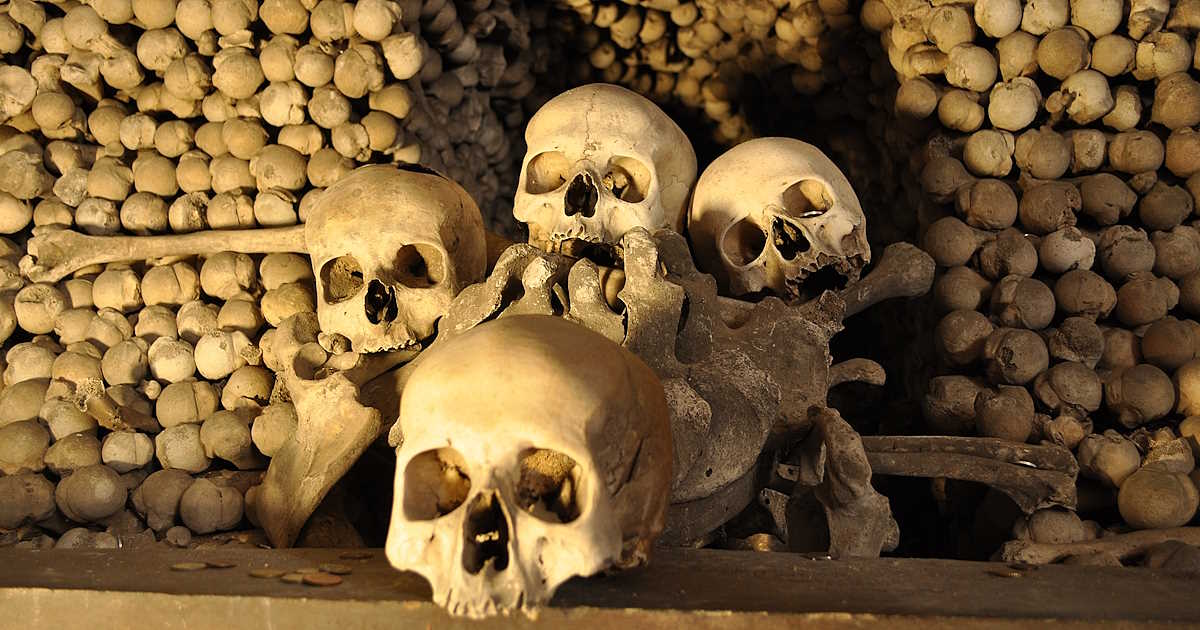Sedlec Ossuary
The Ossuary in Kutná Hora is one of the most famous and fascinating landmarks of its kind in the Czech Republic. It is located about 2 kilometers from the historical center of Kutná Hora.
The Sedlec Ossuary is a unique structure known for its decoration made entirely of human bones. It’s a fascinating site that attracts visitors from all over the world. The ossuary contains the remains of an estimated 40,000 to 70,000 people. It offers a profound glimpse into the past while evoking reflections on life and death (Memento Mori).
The most remarkable decorative elements include a large chandelier containing every bone in the human body and the Schwarzenberg coat of arms made of bones.
The ossuary is open to the public and ranks among the most visited tourist attractions in the Czech Republic.
History
The area where the Sedlec Ossuary stands today was inhabited as early as prehistoric times (around 2500 BC). The ossuary’s history dates back to the 13th century, when Kutná Hora was one of the largest cities in the country. A Christian cemetery belonging to the Sedlec Monastery served as the local burial ground. The cemetery was extensive, about 35 hectares (slightly smaller than Prague’s Wenceslas Square, which is 45 ha). An older church likely stood where the ossuary stands today.
The famine of 1318, the plague epidemic of 1348, the Hussite Wars, and normal mortality rates led to the accumulation of a large number of human remains.
Another event contributed to the cemetery’s popularity: according to legend, a Cistercian abbot brought back a handful of sacred soil from Golgotha in Jerusalem. The soil was scattered across the Sedlec cemetery, making it holy ground. As a result, the cemetery gained immense popularity, and people from distant parts of Europe desired to be buried there.
When the cemetery was later reduced in size, the remains had to be moved. It was decided to build a new church with an underground ossuary to store the bones in mass graves.
V druhé polovině 14. století začala stavba karneru – dvojpodlažní budovy, která měla v podzemí kostnici s kaplí pro službu zemřelým a část s nadzemní kaplí pro bohoslužby.
In the second half of the 14th century, construction began on a two-story charnel house (karner), with the ossuary and chapel for the dead below and a chapel for worship above. The remains were exhumed, cleaned, and stored in the underground chambers — not as a burial, but as a way to preserve and organize the bones.
A 16th-century legend tells of a half-blind monk who was the first to arrange the bones into artistic shapes. During his work, his eyesight was miraculously restored.
During the Hussite Wars, part of the charnel house was damaged, though less severely than the nearby monastery. The underground ossuary suffered only minor damage, while the upper part, including the vault and roof, was affected more.
From the 15th to the 17th century, the underground spaces were expanded to their current size. The arrangement of bones was refined, and structures such as bone pyramids were created.
At the beginning of the 18th century, the building was restored alongside the neighboring Church of the Assumption of Our Lady and St. John the Baptist, under the direction of the renowned architect Jan Blažej Santini-Aichel.
In the early 19th century, the estate — including the ossuary — was purchased by the Schwarzenberg family, who commissioned woodcarver František Rint to clean, bleach (using limewater), and artistically arrange the bones. His work gave the ossuary its present appearance, including the chandelier, the Schwarzenberg coat of arms, pyramids, and other decorations made of human bones. Rint’s signature, crafted from small bones, can be found to the right under the staircase.
Visitor Information
Opening hours:
Mon–Sun 9:00–18:00 (main season: April–September)
Mon–Sun 9:00–17:00 (shoulder season: October or March)
Mon–Sun 9:00–16:00 (off-season: November–February)
Closed on December 24
Admission (Cathedral & Ossuary):
220 CZK – Adults
170 CZK – Students and seniors
80 CZK – Children and disabled visitors
If you plan to visit St. Barbara’s Church as well, it’s best to buy a combined ticket for all three sites.
Tickets are not sold on-site – purchase them online or at the Sedlec Information Center, Zámecká 279 (100 meters from the church).
Photography: Photography inside is not allowed, even for a fee.
Public restrooms: Available at the Sedlec Information Center, Zámecká 279 (100 meters toward the cathedral). Paid, card payment accepted.
Parking: Usually easy to find. Parking is available near the cathedral and around the ossuary.
Getting to the Ossuary
Getting to the Sedlec Ossuary from Kutná Hora city center is simple, and there are several options:
On foot:
If you enjoy walking, the route is about 2 km and takes roughly 25–30 minutes. From the center, go along Barborská Street, cross Palackého Square, continue on Štefánikova Street, then follow Zámecká Street to Sedlec, where the ossuary is located.
By public transport: Take bus line 1 or 7 from Kutná Hora’s center to the stop Sedlec, Kostnice.
By train: From Kutná Hora Main Station, it’s just one stop to Kutná Hora–Sedlec. The ossuary is a short walk from the station. You can also arrive from the other side via Kutná Hora Město station.
By car: The drive from Kutná Hora’s center to Sedlec takes only a few minutes. Follow the signs for Sedlec; visitor parking is available near the ossuary.
More information:

